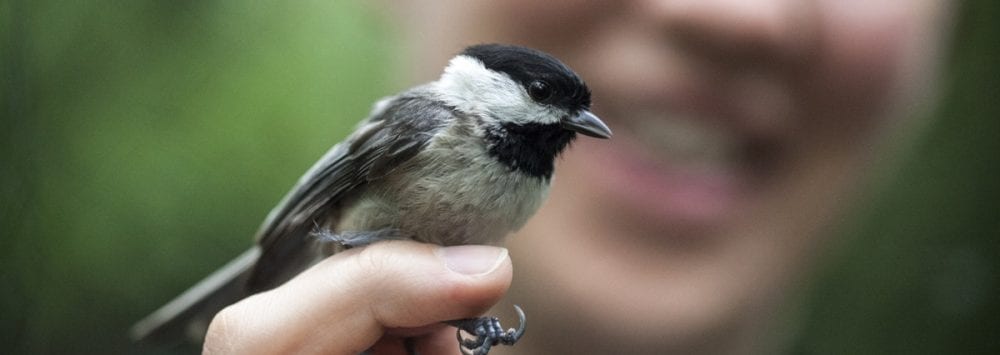Reproductive isolation between hybridizing species
Hybridization occurs when individuals from different species mate and produce offspring. Natural hybridization is widespread, and provides an opportunity to study the pre- and postzygotic barriers that reduce gene exchange between groups or species, maintaining species boundaries. In the Rice Lab, we seek to understand the many forms of reproductive isolating barriers acting between hybridizing species, the genomic signatures of reproductive isolation, and how these barriers and signatures vary with the environment and across space. We use hybridizing black-capped (Poecile atricapillus) and Carolina chickadees (P. carolinensis) as our model system for investigating reproductive isolation. Conveniently, Lehigh University is found within the hybrid zone (McQuillan, Huynh et al. 2017)!

A Carolina chickadee flies out of a nesting snag at one of our field sites. Photo credit: Christa Neu/Lehigh University
We have found that both climatic factors and species interactions influence the degree of range overlap between these two songbird species (McQuillan & Rice 2015), which affects the opportunity for hybridization. We have also found that hybrid chickadees show learning and memory deficiencies compared to pure black-capped and Carolina chickadees (McQuillan et al. 2018), which could have negative impacts on hybrid fitness. To our knowledge, this is the first demonstration of hybrid deficiencies in learning and memory. Future research will aim to determine the influence of genetics on these cognitive differences; to determine the neurobiological basis of these cognitive differences (in collaboration with Dr. Timothy Roth at Franklin and Marshall College); and to test for genomic signatures of selection and hybrid dysfunction (in collaboration with Dr. Scott Taylor at the University of Colorado Boulder). Additionally, we have an ongoing project investigating the possibility that chemical signals are contributing to prezygotic reproductive isolation.
Population genetics of character displacement-initiated speciation
When closely related species co-occur, they often compete for resources or interfere in each others’ reproduction. If these interactions result in reduced fitness, then selection is expected to favor individuals of each species with traits that reduce the likelihood or severity of these interactions. Over time, this can lead to divergence between the species in these traits, a process known as character displacement. However, character displacement only happens in populations where the species co-occur; nearby populations with only a single species will not undergo character displacement. This can lead to incidental divergence between populations of the same species that have and have not undergone character displacement. If this divergence leads to reproductive isolation, then character displacement can be said to initiate speciation.
Experimental work done in collaboration with David and Karin Pfennig at UNC shows that reproductive isolating barriers have arisen between populations of spadefoot toads that have and have not undergone character displacement (Pfennig & Rice 2007; Pfennig & Rice 2014). The Rice Lab has used population genetics and landscape genetics approaches to investigate whether gene exchange is reduced between these spadefoot toad populations, as expected when reproductive isolating barriers are present. We have found evidence that neighboring spadefoot toad populations that have and have not undergone character displacement show signatures of reduced gene exchange (Rice & Pfennig 2010; Pfennig & Rice 2014; Rice et al. 2016). Future work will evaluate the genomic extent of this divergence.

